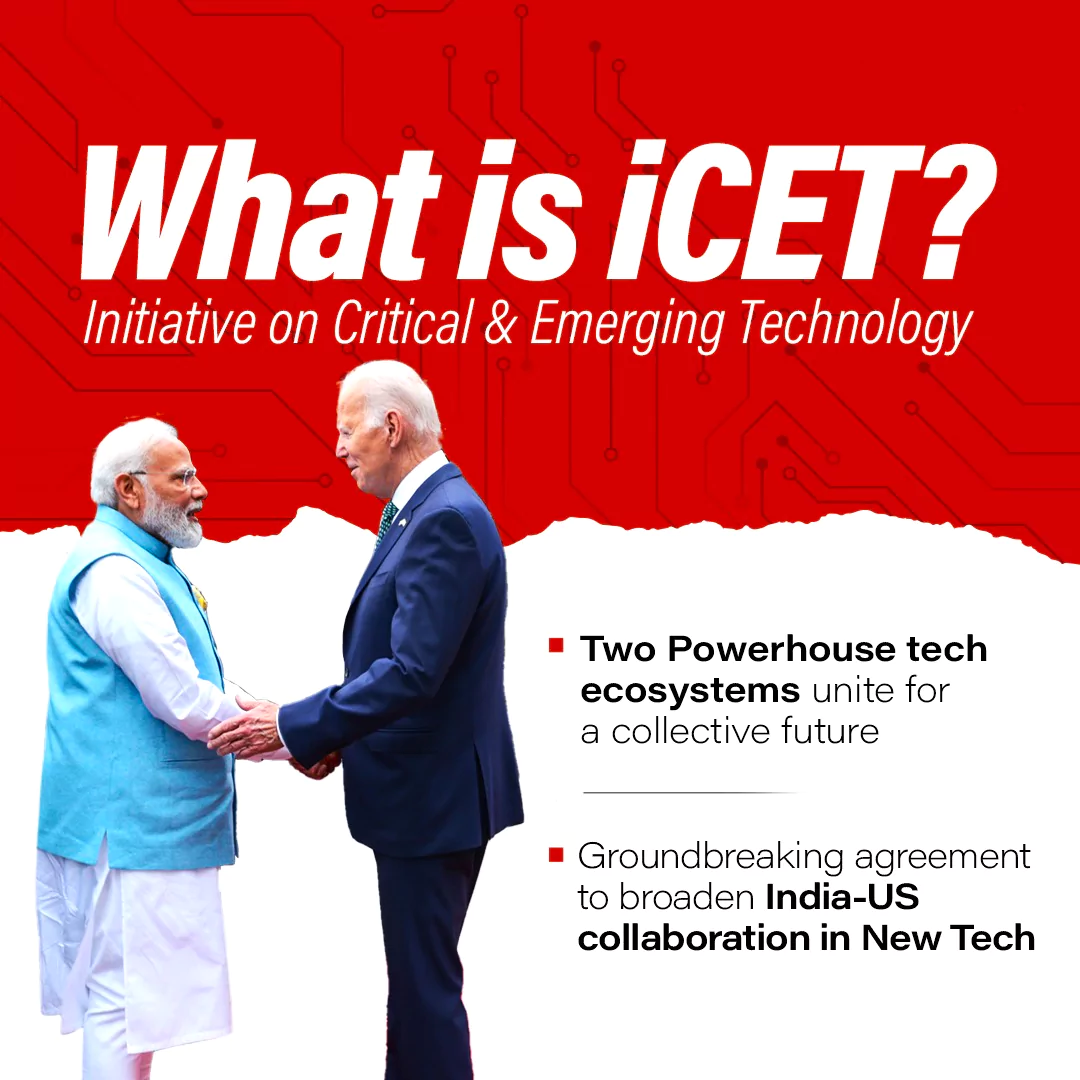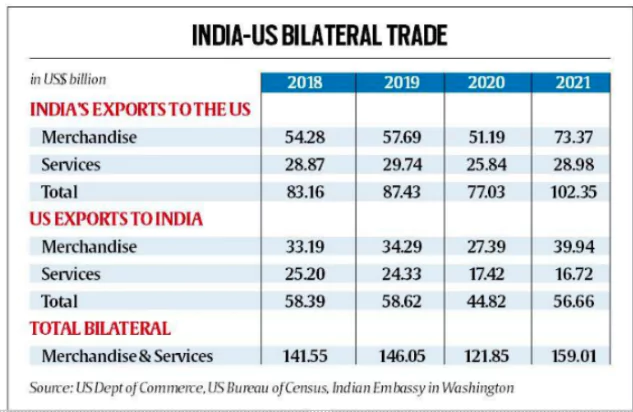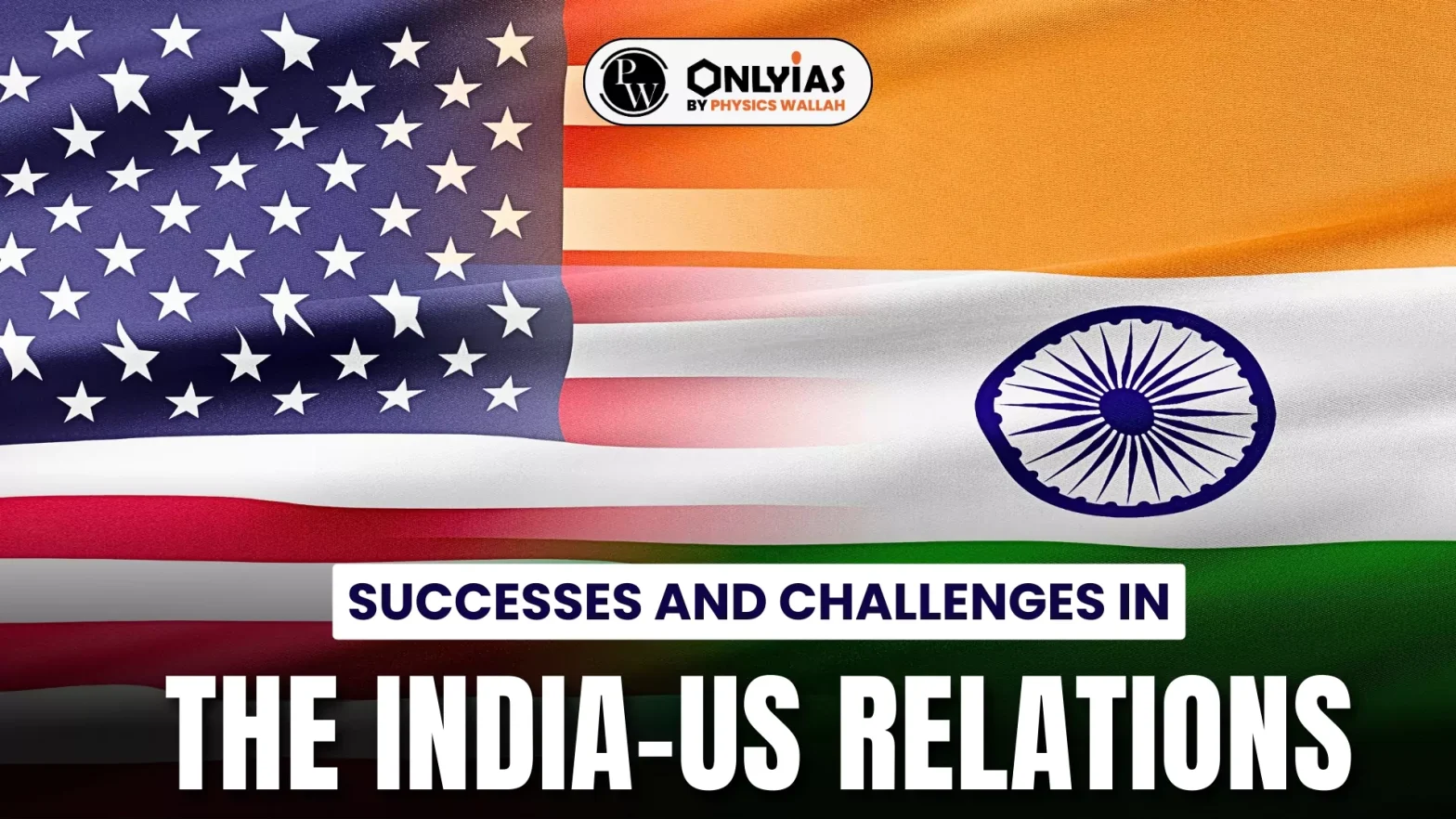The Indian Prime Minister and the U.S. President are set to meet this week at the G-7 outreach summit in Italy.
About India-US Relations

- Basis: The strategic partnership between the United States and India is based on a mutual dedication to democracy and preserving the rules-based international order.
- Background & Evolution:
- 1949: Prime Minister Pandit Jawaharlal Nehru meets with US President Harry S. Truman on a multi-week tour of the United States.
- 1998: India conducted a series of nuclear tests, which led to a period of strained relations with the US.
- 2008: The NSG granted a waiver to the Indo-US nuclear deal, effectively ending India’s isolation from the nuclear mainstream and technology denial regime. This waiver allowed for increased collaboration in nuclear technology and trade.
- 2010: The first US-India Strategic Dialogue was convened.
- 2016: Prime Minister Narendra Modi addressed the US Congress, emphasizing overcoming historical hesitations.
- 2023: The US hosts a State Visit for Indian PM Narendra Modi.
- Strengthening Ties:
- Dialogue Mechanism: Both governments have established over 50 bilateral dialogue mechanisms to facilitate effective communication and collaboration.
- Collaboration in Multiple Areas: Despite the challenges posed by the COVID-19 pandemic, India and the US have actively cooperated across multiple areas, such as defence, security, healthcare, trade, economy, science and technology, etc.
- Reduction of Past Constraints: Historical issues such as concerns over Jammu and Kashmir and the relationship dynamics with Pakistan (de-hyphenation) have been effectively managed.
Enroll now for UPSC Online Course
Significance of India-US Relations
- Defence Cooperation: The defense dialogue began in 1995 with the setting up of the Defence Policy Group at the level of the Defence Secretary and his Pentagon counterpart and three Steering Groups to develop exchanges between the Services.
- India-US defence cooperation is based on the “New Framework for India-US Defence Cooperation”, which was renewed for ten years in 2015.
- In 2016, the defence relationship was designated as a Major Defence Partnership (MDP).
- In 2018, India was moved into Tier-1 of the US Department of Commerce’s Strategic Trade Authorization license exception.
- Bilateral Exercises: India conducts more bilateral exercises with the U.S. than with any other country, such as Tiger Triumph, Vajra Prahar, Yudh Abhyas, Cope India, and the Malabar Exercise.
- SoS & RDP Agreement: India and the United States have agreed to initiate negotiations for a ‘Security of Supply’ (SoS) arrangement and a ‘Reciprocal Defence Procurement’ (RDP) agreement, which aim to promote long-term supply chain stability and enhance security and defence cooperation.
- SoS Agreement: A bilateral or multilateral agreement aimed at ensuring the availability and stability of critical supplies, particularly in the field of defence and security.
- RDP Agreement: A bilateral agreement in the field of defence procurement, which is designed to facilitate reciprocal procurement of defence items and promote cooperation in research, development, and production of defence equipment.
Agreements between India and USA
- GSOMIA (a military information agreement): It was signed in 2002 and guarantees that the two countries will protect any classified information or technology that they share.
- It aimed to promote interoperability and laid the foundation for future US arms sales to the country.
- LEMOA (Logistics Exchange Agreement): It was signed in 2016 and provides the framework for sharing military logistics.
- COMCASA (Communications Security Agreement): Signed in 2018, it enables the US to supply India with its proprietary encrypted communications equipment and systems, allowing secure peacetime and wartime communications between high-level military leaders on both sides.
- Basic Exchange Cooperation Agreement (BECA): This agreement, signed in 2020, helps India gain real-time access to American geospatial intelligence, which will enhance the accuracy of automated systems and weapons like missiles and armed drones.
- Technology and Information Sharing Agreement (TICA): This agreement allows the two countries to share information about technologies used for defense purposes.
|

- Economic Engagement:
- Bilateral Trade: $118.28 billion in 2023-24.
- India is the 9th largest trading partner of the US.
- The US was India’s largest trading partner, with bilateral trade in goods and services crossing US$ 191 billion in 2022.
- India’s trade surplus with the U.S. was $36.74 billion in 2023-24. America is one of the few countries with which India has a trade surplus.
Check Out UPSC CSE Books From PW Store
About iCET
The Initiative on Critical and Emerging Technologies is a framework agreed upon by India and the U.S. for cooperation on critical and emerging technologies in areas including artificial intelligence, quantum computing, semiconductors and wireless telecommunication.
- Launch: In January 2023 to strengthen their strategic partnership and drive technology and defence cooperation.
- Aim: Both affirm that the ways in which technology is designed, developed, governed, and used should be shaped by our shared democratic values and respect for universal human rights.
- Focus Areas: To build supply chains and support the co-production and co-development of items.
|
-
-
-
- The US was the largest partner in 2021-22 and 2022-23.
- Foreign Direct Investment (FDI): The US is the third largest investor in India, with FDI Investments of $63.03 billion from April 2000 to December 2023.
- During 2022-23, the US was the third largest source of FDI into India, with inflows of US$ 6.04 billion accounting for almost 9% of total FDI equity inflows.
- Strategic Underpinnings:
- Quadrilateral Security Dialogue (Quad):
- The Quad, comprising India, the United States, Australia, and Japan, was initially established after the 2004 Indian Ocean tsunami but gained strategic significance in 2017.
- The Quad primarily counters China’s growing influence in the Indian Ocean rim and focuses on strengthening the Indo-Pacific region.
- It is a forum for the four countries to enhance cooperation and address regional challenges.
- I2U2 Grouping:
- The I2U2 grouping comprises India, Israel, the United States, and the United Arab Emirates.
- This grouping is dedicated to joint investments and new initiatives in various sectors, including water, energy, transportation, space, health, and food security.
- US-India Initiative on Critical and Emerging Technologies:
- In January 2023, National Security Advisor Ajit Doval and his US counterpart Jake Sullivan launched this initiative.
- The partnership focuses on critical and emerging technologies to enhance India’s role in the global electronics supply chain.
- The collaboration includes efforts to align India’s chip manufacturing incentive scheme with other global initiatives, mainstreaming foreign chip firms and industry leaders.
- It also seeks to avoid duplication of efforts and diversify the sourcing supply base for semiconductor chips.
- Energy Partnership/ Climate & Clean Energy Agenda 2030: In April 2021 an India-U.S. Climate and Clean Energy Agenda 2030 Partnership was launched, with two tracks i.e. Strategic Clean Energy Partnership (SCEP); and Climate Action and Finance Mobilization Dialogue (CAFMD).
- S&T and Space Cooperation: The Science and Technology Cooperation Agreement signed in October 2005, was renewed for 10 years in September 2019. The Indo-US Science and Technology Forum (IUSSTF), promotes cooperation in S & T and innovation.
- For Example: ISRO and NASA are developing a microwave remote sensing satellite for Earth observation, NASA-ISRO Synthetic Aperture Radar (NISAR).
- Education & Cultural Cooperation:Under the Fulbright-Nehru binational Program, both countries support Fulbright-Nehru scholarships and grants to US and Indian scholars, professionals and students.
- The Global Initiative of Academic Networks (GIAN) was launched by India in 2015 to facilitate visits by 1000 U.S. teachers annually to teach in India. GIAN has been extended to other countries also
- Diaspora/People-to-People ties: About 4.4 million Indian Americans/Indian origin people reside in the US. Persons of Indian origin (3.18 million) constitute the third largest Asian ethnic group in the US.
Enroll now for UPSC Online Classes
Challenges in the India-US Relations
- Different Stand on Various Geopolitical Issues: In early 2022, India’s neutrality on Russia’s aggression against Ukraine—and India’s abstention on all U.N. votes condemning or criticising that invasion—met with dismay among some Members of the US Congress.
-
- While the US emphasises international law and humanitarian issues, India considers the impact on global south countries, like disruptions in food and energy supplies.
- Oil Procurement from Russia: India’s increasing procurement of discounted crude oil from Russia has raised questions about the contradiction between India’s partnership with the US and its reliance on Russian oil.
- Trade Protectionism: The US is concerned about India’s turn towards protectionism.
-
- For example, India makes up only two percent of the United States’ merchandise trade due to policies that protect domestic industry from foreign competition.
- Trade issues include visa delays and revoking India’s trade benefits under the Generalized System of Preferences (GSP) program in 2019.
- The US has raised concerns about India’s protectionist trade policy and the existence of entry barriers for foreign investment.
- Indian Dominance in the US H-1B Visas and Emerging Tensions in the Service Sector: Indian citizens are by far the largest skilled migrant group in the US, accounting for over one-third of U.S. H-1B visas issued in recent years.
- This could become a potent issue if employment growth remains weak in the U.S.
- US Criticism of India’s Democracy and Human Rights Record: US organisations and foundations release reports questioning India’s democratic discourse, press and religious freedom, and treatment of minorities.
- In an annual report on human rights practices in India, the US State Department has highlighted challenges to freedom of expression, cases of arbitrary arrests and detentions, and extrajudicial killings in 2022.
- Export Controls and Technology Transfer: The US has significant export controls on India, which were instituted after India’s 1998 nuclear test.
- These controls inhibit the free transfer of technology between the two countries.
- Resolving this issue is crucial to fostering greater collaboration and technological exchange.
- Indo-Pacific Economic Framework (IPEF): The US may encourage India to join the trade pillar of the US-led IPEF.
- India has already committed to three pillars of the IPEF. Still, it has reservations about the trade pillar due to concerns related to the environment, labour, digital trade, and public procurement commitments.
- Minerals Security Partnership (MSP): India has faced challenges in finding entry into the US-led MSP, which aims to secure supply chains of critical minerals and reduce dependency on China.
- The partnership was floated last year and has now been expanded to include a new member, Italy (along with the 11 founding countries and the European Union).
- This exclusion raises concerns within certain sections of the Indian government.
- Strategic Convergence, the China Challenge: While India–US partnership involves far broader and deeper issues, one of the predominant, shared concerns is China’s increasingly aggressive behaviour, in particular along the disputed China—India border.
- On the other multilateral front, and with growing concerns over China’s threats against Taiwan and the latest conflagration over the Philippines in the South China Sea, too, India-U.S. cooperation at the Quad has flagged somewhat.
- Delayed High-level Meetings: Due to the Gaza crisis and other conflicts, various key U.S. officials cancelled planned visits.
- The US President declined the invitation for India’s Republic Day in 2024.
- Planned visits by the U.S. National Security Adviser were cancelled twice this year at the last moment, (due to the Gaza crisis), in turn affecting the iCET review.
- Critical Comments: Comments from the U.S. State Department about India’s state of democracy and religious freedom, along with remarks on Manipur and human rights, led to a diplomatic issue. In response, India summoned a senior U.S. diplomat.
- Focus Shift: U.S. Deputy Secretary of State Kurt Campbell has focused on “Quad-Plus” meetings with other countries, diverting attention from India.
- Tensions over Plots: Amid this discourse, the discovery of an alleged plot involving Indian security officials targeting a U.S. citizen, Gurpatwant Singh Pannun, has added a layer of distrust and complicated the bilateral relationship.
- June 2024 also marks a year since the plot in the U.S. was unearthed, along with transcripts linking the plot to the killing of Canadian citizen Hardeep Singh Nijjar outside Toronto the same month (June 2023).
Way Forward
- Address Concerns: India and the U.S. should focus on resolving diplomatic tensions by addressing concerns over democracy and alleged plots.
- They must also prioritise high-level meetings and strategic cooperation, like the initiative on Critical and Emerging Technology (iCET) review.
- India’s Balancing Act Between US and Developing Nations: The United States pays close attention to India’s leadership in multilateral forums, such as the G20 and the SCO. India can use its leadership positions to act as a bridge between the West and developing nations.
- Enhancing Counterterrorism Cooperation for Regional Stability: Pursue greater cooperation on counterterrorism, including coordinating strategies for managing a Taliban-led Afghanistan and leading multilateral efforts to apply pressure on the Pakistani military intelligence complex to abandon support for terrorist groups.
- Cooperation in Emerging Technologies and Artificial Intelligence (AI): Enhance cooperation in emerging technologies and artificial intelligence (AI) as data regulation, information sharing, and privacy protection become increasingly salient issues crucial to the preservation of national security.
- Advancing Multilateral Coordination: Strengthen coordination multilaterally and on international issues, including prioritising two multilateral strategic dialogues that have gained prominence recently: the Quad and the West Asian Quad or I2U2.
- Boosting Economic Engagement: Increasing investment and trade flows between India and the US is crucial for economic growth, market access, and technological cooperation. The India-US iCET initiative is a positive step.
Check Out UPSC NCERT Textbooks From PW Store
Conclusion
The evolving relationship between India and the US is significant in shaping the global order of the 21st century. By focusing on countering China’s influence, expanding bilateral trade, and addressing key challenges, both nations aim to elevate their relationship to a global strategic partnership.
![]() 13 Jun 2024
13 Jun 2024


